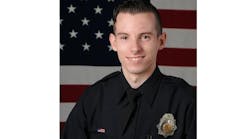Police Supporting High School Drunk Driving Educational Programs
Law enforcement officers provide many services to the community. Most involve situations where citizens are having a really bad day. Fortunately, officers also participate in prevention events that make a difference in people’s lives before tragedy strikes. Recently Creswell High School (OR) participated in Every 15 Minutes, a drunk driving awareness program aimed at high school students. Involving law enforcement, the fire department and other community partners, this program allows first responders to create a scene that just might save the life of a young adult.
Day 1
The program begins with the grim reaper going into a wide selection of classrooms and one by one places his hand on the shoulder of a student and leads them away. This represents the loss of someone every 15 minutes to drunk driving. It involves a cross-section of students showing how it affects everyone regardless of race, gender, education, age and economic status. After the door shuts on the reaper, the police chaplain reads an obituary to the class. Written by the student’s parents, it includes details about the student, such as other family members, and the “former” student’s hobbies, likes and dreams. The obituary is posted in the classroom as a reminder of the child taken away by death.
The student is lead away and only returns to his or her class as the “living dead” after he or she has been made-up with white face paint and donned a black robe. Although they are present with the other students they do not interact or talk with anyone for the rest of the day simulating their departure from this world. At this point, they have also created their own epitaph written on a tombstone that joins the others in a “graveyard” located in a central area of the school. Students and staff going about their educational business pass by them reading the words of their “deceased” classmates and students.
The second part of Day 1 involves the students being in and witnessing a mock drunk driving wreck. The students are brought to the scene where two vehicles have been set-up and several students in moulage including very realistic broken bones and facial injuries are trapped after “hitting” each other. During the recent Every 15 Minutes presentation in Creswell (OR), a student was placed through the windshield of a Chevy Blazer while four other students with a variety of injuries were in a small two door. The driver of the Blazer portrayed the drunk driver. Students watched as a motor officer arrived on scene and assessed the situation. He immediately called for additional officers and the fire department for an extrication crew and paramedics. Quickly on scene, firefighters went to work to triage the students and get them out of the vehicles. Working with a variety of tools, the windshield of the Blazer was torn off the victim and she was lifted onto a backboard and carried to the waiting ambulance. As his “girlfriend” was being treated and carried away, the driver was being lead through field sobriety tests. Other fire fighters worked on the second car using a combi-tool to peel back the top to extricate the passengers. During this scene, the grim reaper has walked to the driver’s side of the vehicle and placed his hand on the shoulder of the driver. He has “died.” The front passenger is lifted onto a backboard and carried to a waiting Life Flight. The back passengers are led to another waiting ambulance and the final patient, the deceased driver, is placed on a backboard and covered with a tarp. Next, he is lifted into a waiting hearse driven by a local mortuary.
After the scene, the viewing students and facility return to class while the accident victims head to an off-site location to spend the night simulating what it would be like to be removed from their families and friends. They also write letters to their parents that begin, “Dear Mom and Dad, Every 15 minutes someone dies as a result of an alcohol related collision. Today, I died, and I never got the chance to tell you…” This evening, the family of the “deceased” student is also visited by a sheriff’s deputy who issues a death notification.
Day 2
The second day of Every 15 Minutes includes an assembly open to students, family, friends and community members. During the assembly, the “dead” student’s letters are read, and also, a number of speakers come and explain how drunk driving has affected their family. Often these speakers include the parents of an actual victim. The parent(s) who received the mock death notification also speak about the emotional impact this had on them as well. At the end, the students are able to participate in a pledge that they will not drink and drive or get into a vehicle with someone who has been drinking.
Not a Scare Tactic Program
Every 15 Minutes is designed to focus on the students, the family and the community. It shows how far reaching the impact of losing someone, particularly a youth to a drunk driving accident is. It educates students and faculty. Teenagers are extremely visual and during this stage of neurological development they have increased learning capacity and fantastic memories. In addition, their frontal lobes are immature which affects their impulsivity and decision making. Every 15 Minutes is designed to present a visual scene to them complete with the emotions of seeing the grim reaper lead off people they know, or themselves be lead away, see the headstones, the accident scene and hear the letters. One of the most impactful parts for the Creswell students involved as the “walking wounded” in the back of the two-door was the sound of the glass breaking and the metal snapping as it was ripped through and peeled up during extrication. Even with the lack of fore-sight teenagers can have and the poor decision making, hopefully these students will remember the sights, sounds and feelings of this event and it will help guide them to a phone to call a parent.
Collaboration
Every 15 Minutes is often presented by local law enforcement. For example, the Creswell High School program was coordinated through the Lane County Sheriffs Office (LCSO). The local fire department, in this case South Lane County Fire & Rescue, also assists along with Life Flight members. The school district is a huge supporter as well because without them this program could not be presented. Some schools have declined to have the event because parents felt it was too graphic for their children. Other community members get involved, including those who moulage the students and those who speak at the assembly. Local media often covers the event spreading its influence. Many videos can be found on You Tube allowing the program to reach out to teens beyond the boundaries of the involved high school.
Funding
Many programs are paid for by a grant. First responders donate their time and the equipment and apparatus involved are granted by the local police and fire department management. Mini-grants are available after the event is performed as well.
Being a first responder during this drill, especially when I had a sophomore son in the audience, was an emotional experience. Although my focus was on the “mock” victim on the car hood, seeing the children involved and knowing what I was doing might impact my son’s decision to drink and drive or ride with a drunk driver one day made me glad I was spending time participating in this program. Hearing the obituaries and the seeing the grim reaper gave me chills. Prior to the program, I talked to the father of the “deceased” child last time the program was offered in our area. A career fireman, he said that although he knew it was coming and that it was fake, he wasn’t prepared for the feelings that came when he answered that door and heard the news. This program has teens talking. The visuals are in their brains. The information is out there. With Creswell High’s prom only a week after the event, I hope it helps guide our children to make the right decision. This program might just save a life or two.
Web Links:
About The Author:
Michelle Perin has been a freelance writer since 2000. Her credits include Law Enforcement Technology, Police, Law and Order, Police Times, Beyond the Badge, Michigan State Trooper, Michigan Snowmobiler Magazine and Chief of Police. She writes two columns a month for Officer.com. Michelle worked for the Phoenix (AZ) Police Department for almost eight years. In December 2010, she earned her Master’s degree in Criminology and Criminal Justice from Indiana State University. Currently, Michelle works as the Administrative Coordinator at Jasper Mountain a residential psychiatric facility for children. In her spare time, she enjoys being the fundraising coordinator for the Lane Area Ferret Shelter & Rescue, playing her bass, working on her young adult novel Desert Ice and raising her two sons in a small town in Oregon.

Michelle Perin
Michelle Perin has been a freelance writer since 2000. In December 2010, she earned her Master’s degree in Criminology and Criminal Justice from Indiana State University.


